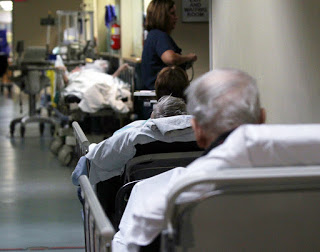The Quality Myth:
Complying with best practices or standards, national or international, is only a start to build a foundation for a safe and standardized care. However, this is not how it’s being perceived or marketed among regulators and most healthcare organizations, let alone that meeting standards does NOT by any mean guarantee positive results or outcomes of care. Expert knowledge and studies have supported this claim.
Unfortunately, many organization mistake complying with “accreditation” standards with the notion of achieving the right level of quality and safe care. In fact, doing that may actually jeopardize safety and quality of care by settling with minimum requirements, adopting a very rigid view point, or focusing on documentation rather than sustainable changes in actual practices. Because of that, resources are mobilized and consumed with no room left for creative problem solving or daily continuous improvement. Staff in such organizations, using their own words, have become robots memorizing and following a set of external standards, often without even knowing the rationale behind them. When a situation arises that calls for innovative solutions or new ideas, they seldom step up, much like a linear school system based on fixed subjects evaluated by final exam results only. So, instead of investing on people to lead and improve quality and safety, those hospitals have created disengaged and uninterested work force that get real hype only by checking a box on a piece of paper, or on a screen for that matter.
Decision makers in healthcare organization need to understand clearly that writing a policy or adding a checklist does not guarantee good outcomes, let alone improving patient experience making it more patient-centered. They need to ask the questions: what is a “good” outcome of care they aspire to provide to their patients, and how does complying with the same standard over and over again achieve that?.
I recall looking at one Linkedin post by a very famous hospital group in an Asian country. The post advertises the attainment of accreditation by the JCI, and states that it has achieved the most prestigious excellence award in healthcare quality in the world. I’m not sure if JCI claims that, or if accreditation can be considered an excellence award!
The problem with many healthcare organizations seeking international or even national accreditation is that their main goal, is to market their services and acquire more patients, and hence more business, or to satisfy regulatory requirements.
One of the private hospitals I know which somehow succeeded in achieving multiple international accreditation, mentions in its documents that they support a continuous improvement culture through complying with accreditation standards. Not only this is a flawed understanding of what continuous improvement is, but when you ask the concerned staff about the standards they were accredited for, and are expected to apply in their daily work, you only get blank faces!
I’ve had the chance to work across a number of healthcare organizations, that have obtained different accreditation status, both governmental and private. Yet, and I’m not trying to be delicate, are notorious of being providers of poor quality and less compassionate care, a confession made by their own staff. This acknowledgement of those who are closest to the patient is enough to indicate that obtaining accreditation has no significant impact on the system of care.
The accrediting and regulatory bodies do also play a role in this misconception and malpractice. They need to revisit their strategies, and the criteria used in the evaluation of quality and safety in any healthcare organization, and how big is the value of granting accreditation for the communities served.
The IOM landmark report “Crossing the Quality Chasm” published in 2001, showed that healthcare systems were broken, misaligned, and fragmented. Sadly, the same problems still exist today, and the number of patients suffering from medical errors and poor quality of care are on the rise despite all the advances on the medical field and the efforts to improve quality and safety.
On the flip side, there are some great examples around the world of healthcare organizations who succeeded somehow in pinpointing reasons of many common issues, whether it’s lack of vision and leadership, rising costs, miscommunication, medical errors, wasted time and energy on things that adds no value, or lead to patient dissatisfaction and demotivated or burnt-out workforce, to mention a few. Then, they have put countermeasures in place to overcome those issues with surprising results.
Some organizations adopted lean healthcare and continuous improvement as their everyday philosophy with a great deal of success, setting an example and paving the way for other healthcare organizations to follow or at least look critically at how they view quality and safety of care, and what they really need to change.
So, the question for all policy makers, healthcare leaders, and accreditation bodies: what would add more value (outcome/cost) to a healthcare organization and it’s “customers” of care, the hassle to become accredited, or investing in continuous improvement culture and practices?
Regardless of the answer, I believe we will conclude that a hard look at the state of affairs with this regard is desperately needed.




